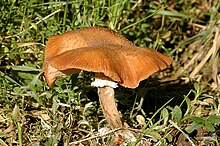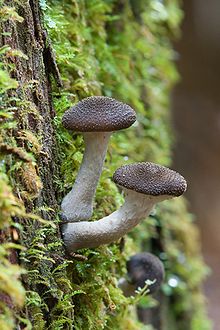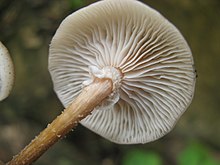List of Armillaria species

classified in the family Physalacriaceae of the Agaricales, the gilled mushrooms.[2] The majority of species in Armillaria are saprotrophic and live mainly on dead wood, but some are parasites that can cause root and butt rot in over 600 species of woody plants.[3] Some Armillaria species form mycorrhizae with orchids;[4] others, such as A. gallica, A. mellea, and A. tabescens, are bioluminescent.[5]
Armillaria species form fleshy, white-
rhizomorphs—rootlike aggregations of hyphae—that can form massive, long-lasting underground networks. The growth of the rhizomorph networks allows for tree-to-tree spread of the fungus even when direct contact between diseased and healthy plants is not possible.[6]
The genus once served as a
synonym Armillariella. A comprehensive 1995 study by Tom Volk and Harold Burdsall evaluated all of the epithets that have been used in Armillaria or Armillariella. They determined that about 40 species belong to Armillaria sensu stricto (in the strict sense); the remaining names belong to species that are distributed among 43 other modern fungal genera.[7]
Many species are difficult or impossible to distinguish from each other using observable characteristics; laboratory
pure cultures to reliably determine species. Because of the difficulties posed by routine species identification, the use of DNA sequencing and phylogenetic approaches has become a standard method to help clarify relationships between species. Species differ in their geographical distribution and ecological position, host specificity, microscopic and macroscopic features, and also in their aggressiveness in colonizing wood hosts. The following list of Armillaria species is based on the taxonomic overviews provided by Volk and Burdsall in 1995,[8] David Pegler in 2000,[9] and reports of new species that have been published since then.[10][11][12]
Species
- Key to the table of species below
| Image | Photo of the Armillaria species. |
|---|---|
| Name | The binomial name of the Armillaria species.
|
| Authority | The author citation—the person who first described the species using an available scientific name, eventually combined with the one who placed it in Armillaria, and using standardized abbreviations. |
| Year | The year in which the species was named, or transferred to the genus Armillaria. Where the actual year of publication (as defined for the purpose of priority ) differs from the date given in the material, the latter date is given in quotes.
|
| Distribution | The distribution of the species; unless otherwise indicated, this information is obtained from Volk and Burdsall (1995), and Pegler (2000). |







| Image | Name | Authority | Year | Distribution |
|---|---|---|---|---|
| Armillaria affinis | (Singer) T.J.Volk & Burds.[13] | 1995 |
| |
| Armillaria altimontana | Brazee, B.Ortiz, Banik & D.L.Lindner.[12] | 2012 | Western North America | |
| Armillaria apalosclera | (Berk.) A.Chandra & Watl.[14] | 1982 ("1981") |
Asia | |

|
Armillaria borealis | Marxm. & Korhonen[15] | 1982 | Eurasia[16] |
| Armillaria calvescens | Bérubé & Dessur.[17] | 1989 | Eastern North America | |
| Armillaria camerunensis | (Henn.) Courtec.[18] | 1995 | Africa | |

|
Armillaria cepistipes[N 1] | Velen.[19] | 1920 |
|
| Armillaria duplicata | (Berk.) Sacc.[21] | 1887 | India | |

|
Armillaria ectypa | (Fr.) Lamoure[22] | 1965 | Europe |
| Armillaria fellea | (Hongo) Kile & Watling[23] | 1983 | Australia | |
| Armillaria fumosa | Kile & Watling[23] | 1983 | Australia | |

|
Armillaria fuscipes | Petch[24]
|
1909 |
|

|
Armillaria gallica | Marxm. & Romagn.[26] | 1987 | |

|
Armillaria gemina | Bérubé & Dessur.[17] | 1989 | Eastern North America[17] |
| Armillaria griseomellea | (Singer) Kile & Watling[23] | 1983 | North and South America[27] | |
| Armillaria heimii[N 2] | Pegler[31] | 1977 | Africa | |

|
Armillaria hinnulea | Kile & Watling[23] | 1983 | Australasia |
| Armillaria jezoensis | J.Y.Cha & Igarashi[32] | 1994 | Japan | |

|
Armillaria limonea | (G.Stev.) Boesew.[33] | 1977 |
|

|
Armillaria luteobubalina[N 3] | Watling & Kile[34] | 1978 |
|

|
Armillaria mellea | (Vahl) P.Kumm.[36] | 1871 |
|
| Armillaria melleorubens | (Berk. & M.A.Curtis) Sacc.[21] | 1887 | North and Central America | |

|
Armillaria mexicana | Elías-Román et al.[37] | 2018 | Mexico |
| Armillaria montagnei[N 3] | (Singer) Herink[38] | 1973 |
| |

|
Armillaria nabsnona | T.J.Volk & Burds.[39] | 1996 |
|

|
Armillaria novae-zelandiae | (G.Stev.) Boesew.[33] | 1973 |
|
| Armillaria omnituens | (Berk.) Sacc.[21] | 1887 | India | |
| Armillaria pallidula | Kile & Watling[40] | 1988 | Australia | |
| Armillaria paulensis | Capelari[10] | 2008 | South America[10] | |
| Armillaria pelliculata | Beeli[29] | 1927 | Africa | |
| Armillaria procera | Speg.[41] | 1889 | South America | |

|
Armillaria puiggarii | Speg.[41] | 1889 | South America |

|
Armillaria sinapina | Bérubé & Dessur.[42] | 1988 | |
| Armillaria singula | J.Y.Cha & Igarashi[32] | 1994 |
| |
| Armillaria socialis | (DC.) Fayod[43] | 1889 |
| |

|
Armillaria solidipes, popularly known as Armillaria ostoyae [N 4]
|
Peck[46] | 1900 | |
| Armillaria sparrei | (Singer) Herink[38] | 1973 | North and South America | |

|
Armillaria tabescens | (Scop.) Emel[47] | 1921 |
|
| Armillaria tigrensis | (Singer) T.J.Volk & Burds.[48] | 1983 | South America | |
| Armillaria umbrinobrunnea | (Singer) Pildain & Rajchenb.[11] | 2010 | South America | |
| Armillaria viridiflava | (Singer) T.J.Volk & Burds.[49] | 1995 |
| |
| Armillaria yungensis | (Singer) Herink[38] | 1973 | South America |
Notes
- ^ The original spelling of the species name was cepaestipes.[19]
- ^ This was a nomen novum for Robert Heim's Clitocybe elegans,[28] as Maurice Beeli had described Armillaria elegans[29] in 1927 (that species is now placed in Cystodermella).[30]
- ^ a b A. montagnei and A. luteobubalina may represent the same species. If this is so, its correct epithet would be montagnei.[11]
- ^ This species was known as Armillaria ostoyae until a 2008 publication revealed that Charles Horton Peck had described the taxon under a different name in 1900.[45]
References
- ^ Volk and Burdsall (1995), p. 8.
- ISBN 978-0-85199-826-8.
- ISBN 978-0-471-12952-3.
- .
- PMID 17883025.
- PMID 16279413.
- ^ Volk and Burdsall (1995), p. 6.
- ^ Volk and Burdsall (1995).
- ISBN 978-1-898298-64-9.
- ^ PMID 18692378.
- ^ ]
- ^ S2CID 24220972.
- ^ Volk and Burdsall (1995), p. 24.
- ^ Chandra A, Watling R (1981). "Studies in Indian Armillaria (Fries per Fries) Staude (Basidiomycotina)". Kavaka. 10: 63–84.
- ^ Marxmüller H. (1982). "Étude morphologique des Armillaria ss.str. à anneau". Bulletin de la Société Mycologique de France (in French). 98 (1): 87–124.
- ^ PMID 17883035.
- ^ JSTOR 3759703. Archived from the originalon 2012-12-24. Retrieved 2011-02-01.
- ^ Courtecuisse R. (1995). "Taxonomy of some fungi used by the Songola people (Zaïre)" (PDF). African Study Monographs. 16 (1): 45–60.
- ^ a b Velenovský J. (1920). České Houby (in Czech). Vol. 2. Prague, Czechoslovakia: České Botanické Společnosti. p. 283.
- ^ S2CID 85249295.
- ^ a b c Saccardo PA. (1887). "Sylloge Hymenomycetum, Vol. I. Agaricineae". Sylloge Fungorum (in Latin). 5: 83–84.
- ^ Lamoure D. (1965). "Charactères mycéliens et position taxinomique de Clitocybe ectypa (Fr.) F.Moreau". Comptes Rendus Hebdomadaires des Séances de l'Académie des Sciences (in French). 260 (4): 4561–63.
- ^ .
- ^ Petch T. (1909). "New Ceylon fungi". Annals of the Royal Botanic Gardens Peradeniya. 4: 299–307.
- ^ Wingfield BD, Maphosa L, Coetzee MPA, Mwenje E, Wingfield MJ (2009). "Characterisation of Zimbabwean Armillaria using IGS-1 sequences and AFLP analysis" (PDF). Fungal Diversity. 34: 187–96.
- ^ Marxmüller H. (1987). "Quelques remarques complémentaires sur les Armillaires annelées". Bulletin Trimestriel de la Société Mycologique de France (in French). 103 (2): 137–56.
- S2CID 24112504.
- ^ Heim R. (1963). "L'Armillariella elegans Heim". Revue de Mycologie (in French). 28: 85–94.
- ^ a b Beeli M. (1927). "Contribution à l'étude de la flore mycologique du Congo II". Bulletin de la Société Royale de Botanique de Belgique (in French). 59: 101–12.
- .
- ISBN 978-0-11-241101-7.
- ^ S2CID 83496798.
- ^ .
- .
- PMID 21156614. Archived from the originalon 2012-12-24. Retrieved 2011-02-01.
- ^ Kummer P. (1871). Der Führer in die Pilzkunde (in German). Zerbst. p. 134.
- ^ "Index Fungorum - Names Record". www.indexfungorum.org. Retrieved 2023-11-26.
- ^ a b c Herink J. (1973). "Taxonomie václavky obecné – Armillaria mellea (Vahl ex Fr.) Kumm". In Hasek J (ed.). Sympozium o Václavce Obecné Armillaria mellea (Vahl ex Fr.) Kumm (in Czech). Brno, Czechoslovakia: Vysoká Skola Zemĕdĕlská v Brné. pp. 21–48.
- S2CID 85098372.
- .
- ^ a b Spegazzine C. (1889). "Fungi Puiggariani. Pugillus 1". Boletín, Academia Nacional de Ciencias, Córdoba (in Latin). 11 (4): 381–622.
- doi:10.1139/b88-277.
- ^ Fayod MV. (1889). "Prodrome d'une histoire naturelle des Agaricinés". Annales des Sciences Naturelles, Botanique. Série 7 (in French). 9: 181–411. Archived from the original on 2011-09-30. Retrieved 2011-02-01.
- ]
- doi:10.2509/naf2008.003.00717. Archived from the original(PDF) on 2011-07-21.
- JSTOR 2477998. (subscription required)
- OCLC 32072244.
- ^ Volk and Burdsall (1995), p. 115.
- ^ Volk and Burdsall (1995), p. 119.
Cited literature
- Volk TJ, Burdsall HH Jr (1995). A nomenclatural study of Armillaria and Armillariella species (Basidiomycotina, Tricholomataceae) (PDF). Synopsis Fungorum. Vol. 8. Førde, Norway: Eko-trykk A/S. p. 121. ISBN 978-82-90724-14-1.
